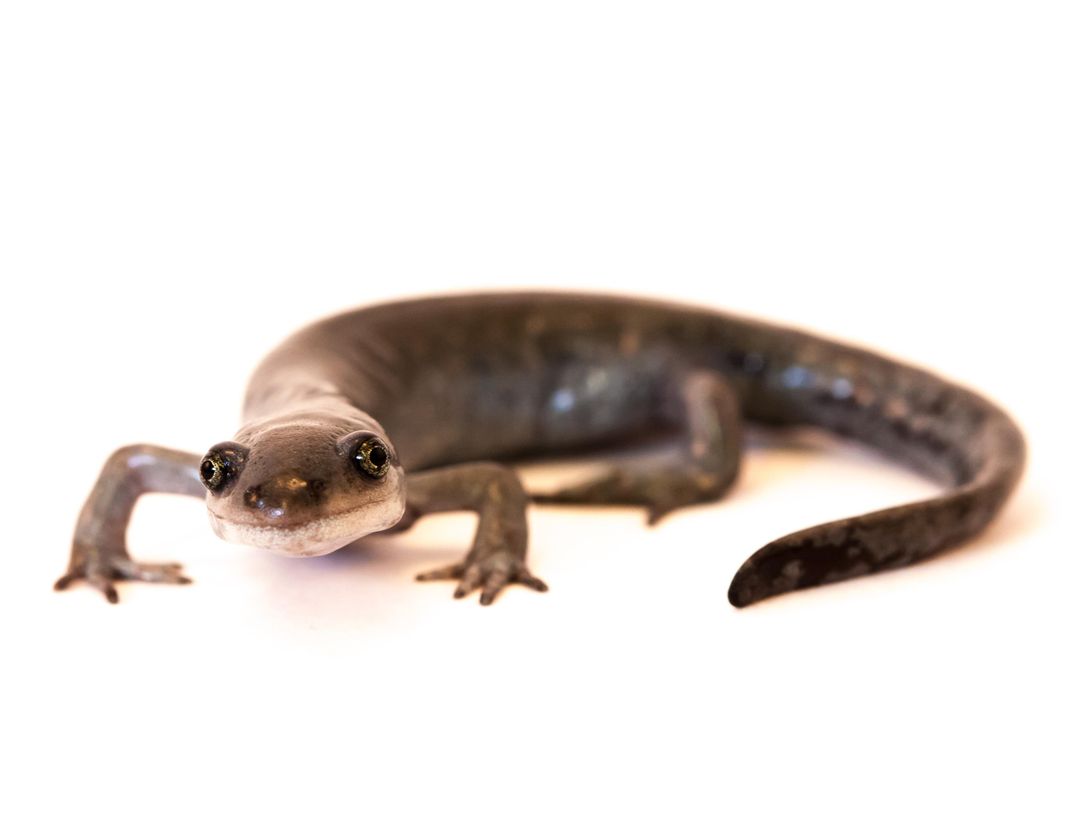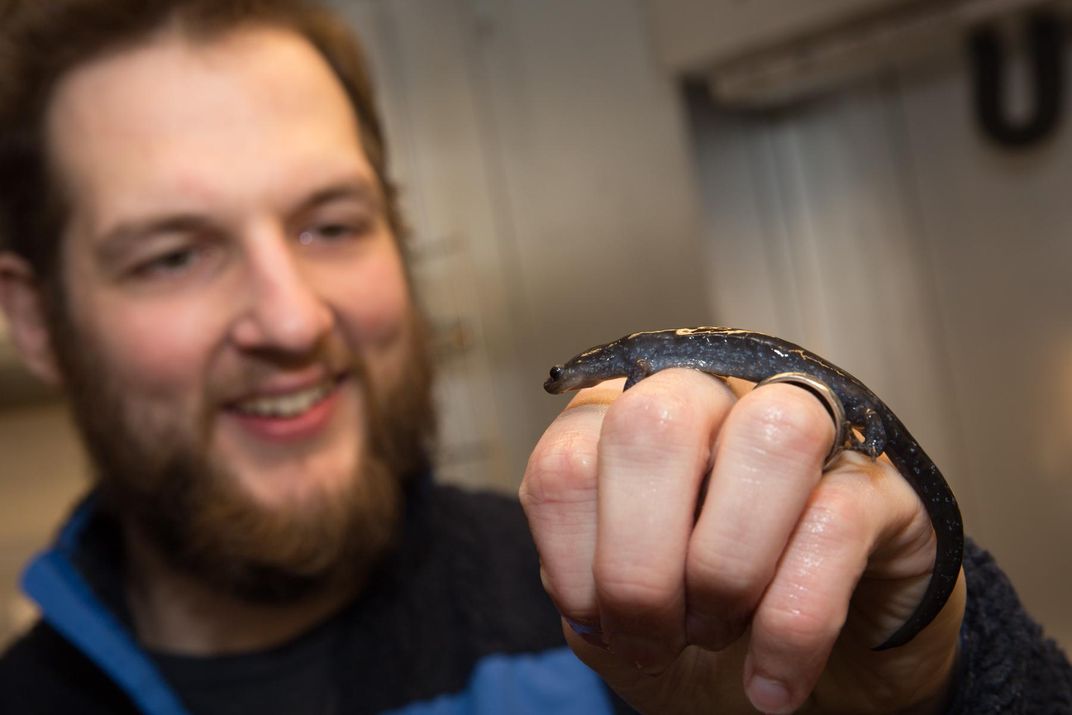When Is Sex Worth Going the Distance? When You’re a Salamander, Apparently
Asexual amphibians may be less equipped to handle modern threats than their sexual counterparts
/https://tf-cmsv2-smithsonianmag-media.s3.amazonaws.com/filer/da/72/da72e065-e449-4817-b051-89a158ee8496/smallmouth_salamander.jpg)
Sex: Who needs it? Not unisexual mole salamanders, which reproduce primarily by cloning and sometimes snatch other species' sperm to kickstart their reproductive systems. These all-female cohorts have been doing just fine for about 6 million years. But new research suggests that in an era of global change, their sexual counterparts may gain an advantage from their (literal) wanderlust.
“These unisexuals are very bad at moving around,” said Rob Denton, a PhD student and research fellow at Ohio State University and the lead author of a study published recently in Functional Ecology. “It’s another clue that these salamanders especially are doing something very strange.”
There are certain advantages and tradeoffs to not having sex, as you may know. These differences especially interest researchers who study amphibians, a group that is keenly vulnerable to threats like climate change, deadly fungal diseases and habitat fragmentation. Examining the complex relationship between amphibians' different strategies of reproduction offers critical clues as to which ones will be most prepared to deal with a changing world.
“Salamander-specific chytrid (Bsal) fungus is a huge concern here in the United States, because we have such a wonderful hotbed of salamander diversity compared to the rest of the world,” says Denton. “Preventing that outbreak from happening here is really important and part of that is understanding the differences on a species level between these animals—how they interact with each other and how they interact with their landscape.”
The small-mouth salamanders Denton studies are found throughout the Great Lakes region and the central U.S.,. They are also adorable. Measuring around five inches long from head to tail, they boast “little pug faces,” short stubby arms, a long nose and “these bulging cartoon eyes,” in Denton’s words. “I don’t think anyone ever saw one and didn’t think it was cute.”
Also called mole salamanders, they spend most of the year underground in burrows, only occasionally emerging during lubricating rains for a snack. But there’s also a related variety of all-female salamanders, usually referred to just as unisexual Ambystoma. And this variety, which often lives alongside the small-mouths, has evolved some unique traits that allow them to break the normal rules of biology.

First off, to kick start their reproductive system into action, the females will steal sticky sperm packets that the males of five other known species of mole salamanders drop to the wetland floor. “Usually that sperm is just used to tell their body, ‘hey, it’s time to make eggs,’” Denton says. But it gets stranger: “Sometimes that sperm genome actually sneaks into that next generation," Denton continues, adding that they still aren't entirely sure how this happens. "It’s essentially equal to them having just a little bit of sex.”
Denton wanted to see whether this kind of cloning with occasional hybridizations, which may occur in other asexual species but is not well-known, gave these all-female salamanders an edge over their procreative counterparts. To test their relative fitness, he and colleagues put 17 small-mouth salamanders and 21 unisexual individuals on a salamander treadmill (literally a damp wheel). Every three minutes, they would remove the amphibians from their workout and flip them on their backs, timing how long it took them to scramble back on their feet to test their tiredness.
The tests showed that the small-mouth males and females could go about four times the distance as the all-female team on average. Sex, it turns out, has its benefits.
But the researchers also wanted to bolster their treadmill results with boots-on-the-ground data. So Denton and team went out into the Ohio spring, once the freezing sleet rain had started to fall. Most small-mouth salamanders are born in these pools, and only leave when they’ve morphed out of their tadpole phase. Once they reach sexual maturity on land, the majority come back to the wetland where they were born, meaning that in a given pond most salamanders will have a similar genetic makeup.
But a small percentage breaks this scheme and sets out for new pastures. These wayfarers “stick out like a sore thumb” genetically in their new pond, Denton says. He and his colleagues cracked open the ice over ponds formed from the melting snow, and set traps for the creatures. Using genetic samples taken from capture specimens, they mapped out diversity to see how far individuals were traveling between ponds on average, and compared them with data from the unisexuals.
They found that in the wild, the sexual species probably move about 2.5 times as far as their counterparts. “The small-mouths can walk really fast on the treadmill and then when you look at genetic data, they also move really long distances in the field,” Denton says.

This provides both benefits and pitfalls for the less-mobile unisexual females. On the plus side, says Karen Lips, a salamander expert and a biology professor at the University of Maryland, College Park, the unisexuals have an advantage when it comes to a contagious fungal disease like Bsal. Since they don’t get around as much, they’re less likely to enter an infected area.
That’s especially important in Europe and Asia, where the fungal disease has ravaged amphibian populations. Biologists are so worried about the fungus spreading to North America that the U.S. Fish and Wildlife Service recently instituted a ban on importing many species of the amphibians for the pet trade.
But the unisexuals' genes may prove a weak spot. Sexual reproduction helps create the kind of diversity that could help salamanders resist Bsal or other diseases. Other than the odd hybridization, unisexuals don’t enjoy this genetic insurance, and could be uniformly wiped out by one strain of a disease. As Lips puts it: “There’s a trade-off."
Climate change poses a different problem. If the unisexuals can’t travel as quickly or as far as other species, they may be more at risk of going extinct as their habitat changes and dries up. Still, mobility can only take you so far. Modern problems like habitat fragmentation due to human development affects all salamanders, regardless of their reproductive preference.
“In this world where we keep fragmenting everything and putting up blockages for these guys, being able to keep moving and moving long distances is probably going to become more and more important,” says Lips.
The only other alternative is to go nowhere and evolve. But it’s uncertain whether the unisexuals are evolving in response to their changing surroundings, and if they are, whether they'll be able to adapt in time.
/https://tf-cmsv2-smithsonianmag-media.s3.amazonaws.com/accounts/headshot/joshua-learn_copy.jpg)
/https://tf-cmsv2-smithsonianmag-media.s3.amazonaws.com/accounts/headshot/joshua-learn_copy.jpg)